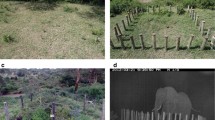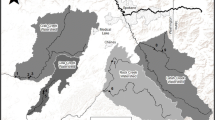Abstract
In this study, we hypothesized that the primary variable determining species responses and interactions within wet/mesic riparian meadows in central Nevada, USA was the water table but that the direct and indirect effects of livestock grazing modified both species responses and interactions. We tested this hypothesis for two widespread riparian species, Carex nebrascensis and Poa pratensis ssp. pratensis, that co-occur but have maximum expression at different water tables. Carex nebrascensis has widely spread tillers typical of ‘guerilla’ plant architecture, while P. pratensis has closely spaced and compact tillers typical of ‘phalanx’ plant architecture. Individuals of both species were grown at mid-and low water tables with or without neighbors and were either clipped or not clipped at the end of the first growing season. For the study site with the most complete record, mean water-table depth during the growing season (May through August) on the mid sites was −32 cm in year 1 and −7cm in year 2. Water-table depth on the low sites was −69 cm in year 1 and −31 cm in year 2. Plant survival, tillering, biomass, and seed production over a 2-yr period were used to quantify the species responses. Water table had no effect on tillering or biomass of C. nebrascensis, indicating that it is adapted for growth and persistence over the range of water tables examined. In contrast, growth and tillering of P. pratensis was severely restricted at more shallow water tables. Poa pratensis had about 50% fewer tillers and lower biomass (9.0 vs 46.5 g) for neighbor-removed plots on mid- than low-water-table sites at one of the study meadows. Further, tiller numbers of P. pratensis increased over time on the low-water-table plots, but decreased on the mid-water-table plots. Clipping had no effect on the survival, tillering, or growth of either species. The clipping treatment may not have removed sufficient leaf mass or may have been applied too near the end of the growing season to elicit a response. Neighborhood removal resulted in a 3- to 10-fold increase in tillering and higher plant mass (1.3 vs. 9.5 g) for C. nebrascensis. Poa pratensis showed an even greater response to neighbor removal. Tillering was 6-to 100-fold greater and mass was 15 to 50 times greater on neighbor removed than neighbor-intact plots. Comparisons between single species and mixed species plots indicated that there was an interaction between the species that limited tiller production in C. nebrascensis. These results indicate that P. pratensis, the ‘phalanx’ species, is capable of more rapidly responding to disturbances that remove neighbors and increase available space than C. nebrascensis, the ‘guerilla’ species. Contrary to previous studies, the interactions between the two species do not seem to be related to plant architecture and can be best attributed to generally greater growth rates and increased competitive ability for P. pratensis at lower water tables. Grazing may further alter the relative competitive ability of the two species in favor of P. pratensis.
Similar content being viewed by others
Literature Cited
Ahlgren, H. A. 1938. Effect of fertilization cutting treatment and irrigation on yield of forage crops. Journal of the American Society of Agriculture 30:683–691.
Allen-Diaz, B. H. 1991. Water table and plant species relationships in Sierra Nevada meadows. American Midland Naturalist 126:30–43.
Belsky, A. J., A. Matzke, and S. Uselman. 1999. Survey of livestock influences on stream and riparian ecosystems in the western United States. Journal of Soil and Water Conservation 51:419–431.
Castelli, R. M., J. C. Chambers, and R. J. Tausch. 2000. Soil-plant relations along a soil-water gradient in Great Basin riparian meadows. Wetlands 20:251–266.
Chambers, J. C. 1991. Patterns of growth and reproduction in a perennial tundra forb (Geum rossi): effects of clone area and neighborhood. Canadian Journal of Botany 69:1977–1983.
Chambers, J. C., D. C. Zamudio, R. R. Blank, and R. J. Tausch. 1999. Soil properties of Central Nevada riparian areas: I. Meadow ecosystem types. Journal of Range Management 52:92–99.
Cheplick, G. P. 1997. Responses to severe competitive stress in a clonal plant: difference between genotypes. Oikos 79:581–591.
Cronquist, A., A. H. Holmgren, N. H. Holmgren, J. L. Reveal, and P. K. Holmgren. 1994. Intermountain Flora. Vascular Plants of the Intermountain West, U.S.A. The New York Botanic Garden, New York, NY, USA.
Crawley, M. J. 1983. Herbivory: The Dynamics of Animal—Plant Interactions. Blackwell Scientific Publications, Oxford, UK.
Dyer, M. I., C. L. Turner, and T. R. Seastedt. 1993. Herbivory and its consequences. Ecological Applications 3:10–16.
Eriksson, O. 1989. Seedling dynamics and life histories in clonal plants. Oikos 55:231–238.
Fox, G. A. 1993. Failure-time analysis: emergence, flowering, survivorship, and other waiting times. p. 253–289. In S. M. Scheiner and J. Gurevitch (eds.) Design and Analysis of Ecological Experiments. Chapman & Hall, New York, NY, USA.
Green, D. M. and J. B. Kauffman. 1995. Succession and livestock grazing in a northeastern Oregon riparian ecosystem. Journal of Range Management 48:307–313.
Humphrey, D. L. and D. A. Pyke. 1998. Demographic and growth responses of a guerilla and a phalanx perennial grass in competitive mixtures. Journal of Ecology 86:854–865.
Kauffman, J. B. and W. C. Krueger. 1984. Livestock impacts on riparian ecosystems and streamside management implications … a review. Journal of Range Management 37:430–438.
Loehle, C. 1987. Partitioning of reproductive effort in clonal plants: a benefit-cost model. Oikos 49:199–208.
Lovett Doust, L. 1981. Population dynamics and local specialization of a clonal perennial (Ranunculus repens). I. The dynamics of ramets in contrasting habits. Journal of Ecology 69:743–755.
Martin, D. W. 1999. Species interactions and recovery potentials of Nebraska sedge/Kentucky bluegrass meadows in central Nevada. Ph.D. Dissertation. University of Nevada, Reno, NV, USA.
Martin, D. W. and J. C. Chambers. 2001. Restoring degraded riparian meadows in the Great Basin: Biomass and species responses. Journal of Range Management 54:284–291.
Martin, D. W. and J. C. Chambers. Restoration of meadows degraded by livestock grazing: above-and belowground responses. Plant Ecology (in press).
McNaughton, S. J. 1993. Grasses and grazers, science and management. Ecological Applications 3:17–20.
Mortimer, G. B. and H. L. Ahlgren. 1936. Influence of fertilization, irrigation, and stage and height of cutting on yield and composition of Kentucky Bluegrass. Journal of the American Society of Agriculture 28:515–533.
Noy-Meir, I. 1993. Compensating growth of grazed plants and its relevance to the use of rangelands. Ecological Applications 3:32–34.
Owen, D. F. 1981. Mutualism between grasses and grazers: an evolutionary hypothesis. Oikos 36:376–378.
Painter, E. L. and A. J. Belsky. 1993. Application of herbivore optimization theory to rangelands of the western United States. Ecological Applications 3:2–9.
Price, E. A. C. and C. Marshall. 1999. Clonal plants and environmental heterogeneity. Plant Ecology 141:3–7.
Ratliff, R. D. and S. E. Westfall. 1987. Dry-year grazing and Nebraska sedge (Carex nebrascensis) Great Basin Naturalist. 47: 422–426.
SAS Institute, Inc. 1995. Logistic regression examples using the SAS System. Version 6. First edition. SAS Institute, Inc. Cary, NC, USA.
SAS Institute, Inc. 1990. SAS/STAT User’s Guide. Version 6. Fourth ed. Volume 1. SAS Institute Inc., Cary, NC, USA.
Schulz, T. T. and W. C. Leininger. 1990. Differences in riparian vegetation structure between grazed areas and exclosuers. Journal of Range Management 43:295–298.
Sala, A. and R. S. Nowak. 1997. Ecophysiological response of three riparian graminoids to changes in the soil water table. International Journal of Plant Science 158:835–843.
Schulz, T. T. and W. C. Leininger. 1990. Differences in riparian vegetation structure between grazed areas and exclosuers. Journal of Range Management 43:295–298.
Seeger, B. L. 1993. Photosynthetic and morphological acclimation of wet meadow graminoids to decreasing soil water availability under natural and glasshouse conditions. MS Thesis. University of Nevada, Reno, NV, USA.
Stromberg, J. C., R. Tiller, and B. Richter. 1996. Effects of ground water decline on riparian vegetation in semi-arid regions: the San Pedro, Arizona. Ecological Applications 6:113–131.
Svjecar, T. J. and G. M. Riegel. 1998. Spatial pattern of gas exchange for montane meadow species. Journal of Vegetation Science. 9:85–94.
Thompson, D. J. and K. W. Clark. 1993. Effects of clipping and nitrogen fertilization on tiller development and flowering in Kentucky Bluegrass. Canadian Journal of Plant Science 73:569–575.
Weixelman, D. A., D. C. Zamudio, and K. A. Zamudio. 1996. Central Nevada Riparian Field Guide. USDA, Forest Service, Intermountain Region, Ogden, UT, USA R4-ECOL-96-01.
Author information
Authors and Affiliations
Rights and permissions
About this article
Cite this article
Martin, D.W., Chambers, J.C. Effects of water table, clipping, and species interactions on Carex nebrascensis and Poa pratensis in riparian meadows. Wetlands 21, 422–430 (2001). https://doi.org/10.1672/0277-5212(2001)021[0422:EOWTCA]2.0.CO;2
Received:
Revised:
Accepted:
Issue Date:
DOI: https://doi.org/10.1672/0277-5212(2001)021[0422:EOWTCA]2.0.CO;2




